Planetary and Space Science (2023); https://doi.org/10.1016/j.pss.2023.105638
A. Waza, J. Kjer, M. Peiteado, T. Jardiel, J. Iversen, K. Rasmussen, J. Merrison
In this laboratory investigation, Mars dust analogues have been mobilized by wind flow under Martian conditions of low density CO2. Various laser based techniques have been employed to quantify dust mobilization and suspension; these include 2D laser Doppler velocimetry, optical opacity and optical reflectance. Direct mobilization of dust has been observed with a threshold shear stress as low as around 0.036 ± 0.007 Pa though only for dust layers of >1 monolayer and at a flux as high as 220 ± 100 mg/m2/s at around 20% above threshold. The dust resuspension fluxes for this direct process have been measured to be significantly lower (order of magnitude) than the mobilization rate, typically around 10 mg/m2/s at a shear stress of 0.15 Pa. This mechanism involved the removal, transport and breakup of dust aggregates. In another mechanism, saltating sand was seen to remobilize deposited dust layers <1 monolayer at a similar mobilization flux of around 50 ± 20 mg/m2/s and with a threshold of around 0.08 ± 0.008 Pa. At the high wind speeds used in these studies a significant fraction of the saltating sand grains become transported at relatively high elevation (>10 cm) and to high velocity. These essentially suspended grains were seen to generate a large flux of dust through impact abrasion. This constitutes a potential mechanism for dust generation on Mars, though is beyond the scope of this study to isolate and investigate
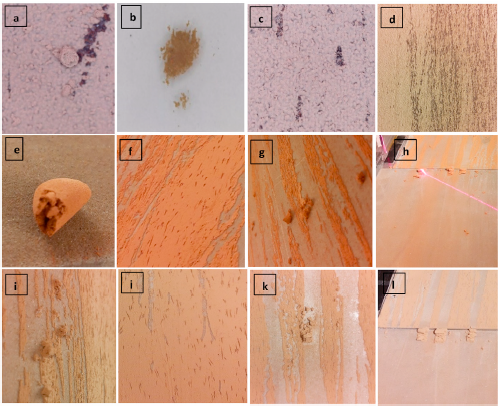
This is a Photograph series of the dust coated immobile sand beds after exposure to wind flow under Mars simulation conditions.
Planetary Science Journal (2023); 10.3847/PSJ/acf318
T. Becker, J. Teiser, T. Jardiel, M. Peiteado, O. Munoz, J. Martikainen, J. C. Gomez Martin, J. Merrison, and G. Wurm
Our earlier laboratory measurements showed that low-velocity sand impacts release fine 5 μm dust from a Martian simulant soil. This dust will become airborne in the Martian atmosphere. Here, we extend this study by measuring aerodynamic properties of ejecta and characterizing deviations from the behavior of spherical, monolithic grains. We observe the settling of particles emitted as part of an impact splash. The sizes (20 to 280 μm) and sedimentation velocities (0.1 to 0.8 m s−1) of the particles are deduced from high-speed videos while the particles sediment under low ambient pressure of about 1 mbar. The particles regularly settle slower than expected, down to a factor of about 0.3. Using optical microscopy, the shape of the captured particles is characterized by simple axis ratios (longest/smallest), which show that the vast majority of particles are irregular but typically not too elongated, with axis ratios below 2 on average. Electron microscopy further reveals that the particles are typically porous aggregates, which is the most likely reason for the reduction of the sedimentation velocity. Due to the reduced bulk density, aggregates up to 10 μm in diameter should regularly be a part of the dust in the Martian atmosphere.
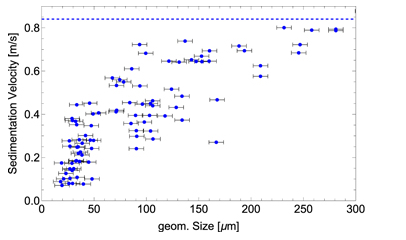
Sedimentation velocity over geometrical size (measured particle diameter) of the 92 observed particles. The dashed blue line is the freefall velocity from the dust bed height. For small geometrical sizes, the measured sedimentation velocity varies by up to a factor of 5 between nearly same-sized particles, while it decreases for increasing geometrical sizes.
Planet. Sci. J. 3 195 DOI 10.3847/PSJ/ac8477 10.3847/PSJ/ac8477
Becker, T., Teiser J., Jardiel T., Peiteado M., Munoz O., Martikainen J., Gomez Martin J.C., Wurm G.
Emission of dust up to a few microns in size by impacts of sand grains during saltation is thought to be one source of dust within the Martian atmosphere. To study this dust fraction, we carried out laboratory impact experiments. Small numbers of particles of about 200 μm in diameter impacted a simulated Martian soil (bimodal Mars Global Simulant). Impacts occurred at angles of ∼18° in vacuum with an impact speed of ∼1 m s−1. Ejected dust was captured on adjacent microscope slides and the emitted particle size distribution (PSD) was found to be related to the soil PSD. We find that the ejection of clay-sized dust gets increasingly harder the smaller these grains are. However, in spite of strong cohesive forces, individual impacts emit dust of 1 μm and less, i.e., dust in the size range that can be suspended in the Martian atmosphere. More generally, the probability of ejecting dust of a given size can be characterized by a power law in the size range between 0.5 and 5 μm (diameter).
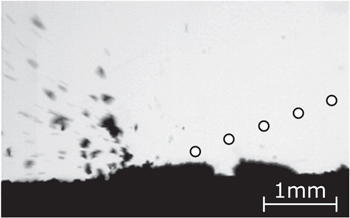
Image of an impact, showing the impactor as a white circle as well as a cloud of ejecta.
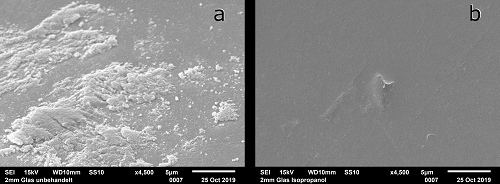
JGR (2022); https://doi.org/10.1029/2022JE007231
S. Aoki, A. C. Vandaele, F. Daerden, G. L. Villanueva, G. Liuzzi, R. T. Clancy, M. A. Lopez-Valverde, A. Brines, I. R. Thomas, L. Trompet, J. T. Erwin, L. Neary, S. Robert, A. Piccialli, J. A. Holmes, M. R. Patel, N. Yoshida, J. Whiteway, M. D. Smith, B. Ristic, G. Bellucci, J. J. Lopez-Moreno, A. A. Fedorova
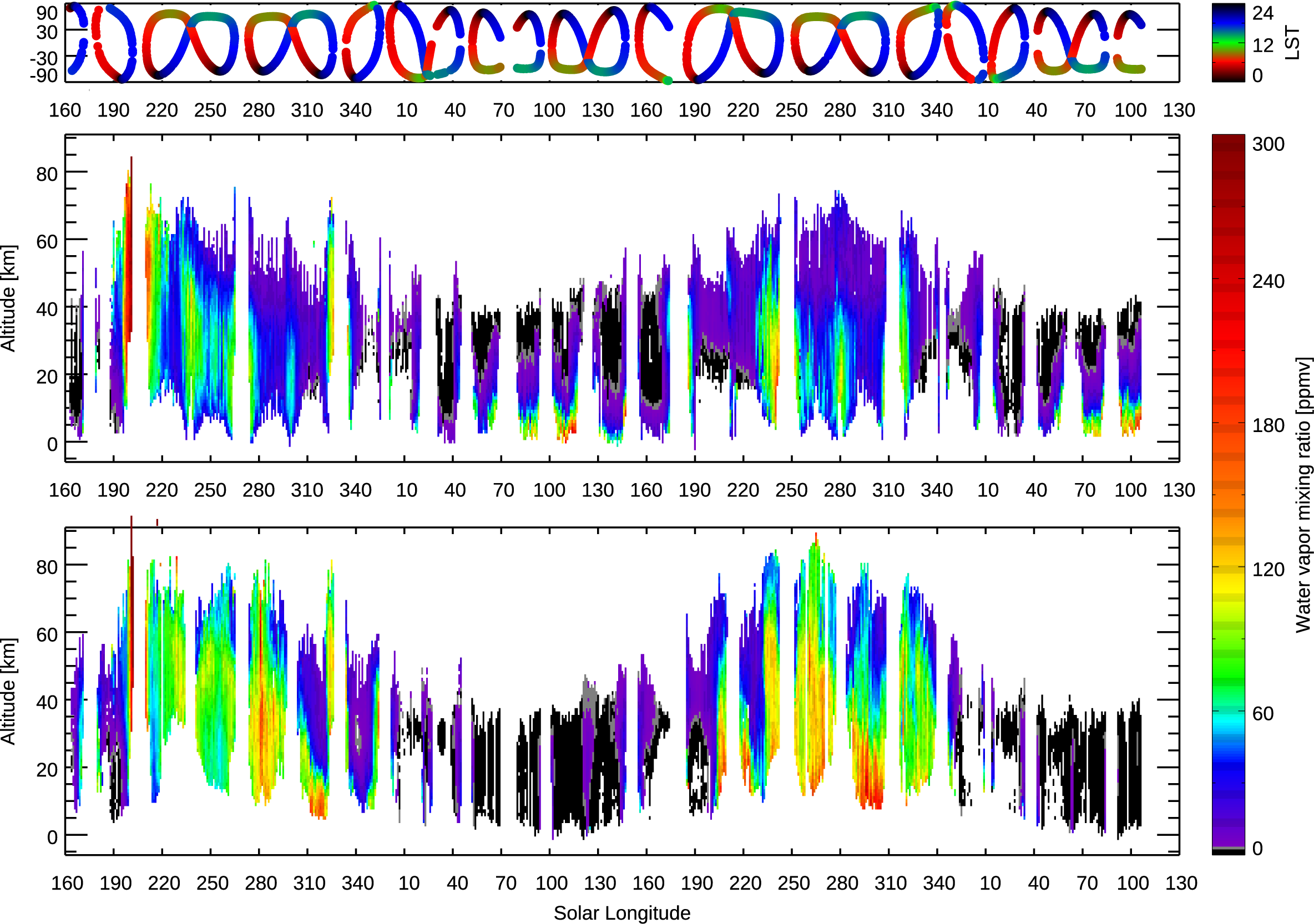
Seasonal variation of the water vapor vertical profiles from LS=160° in MY 34 to LS=130° in MY 36 retrieved from the NOMAD data in the northern hemisphere (the middle panel) and the southern hemisphere (the bottom panel). The retrievals are binned with an interval of 1° of solar longitudes (averaged in latitudes and longitude). The top panel shows the latitudes and local solar time of the measurements (same as Fig. 1). The white represents either no detection or no measurement.
Page 3 of 6

